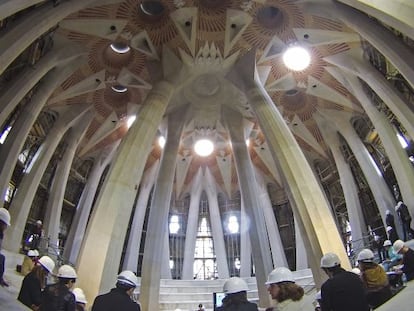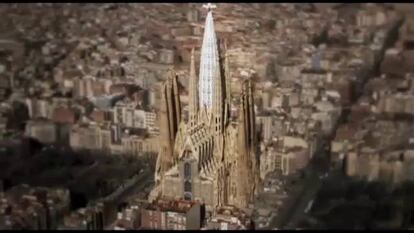Video: How the new towers will take shape at Barcelona’s Sagrada Familia
The Gaudí-designed church has been under construction for more than a century

The annual inspection of the Sagrada Familia – the Antoni Gaudí-designed church in Barcelona that’s still unfinished, more than a century after construction work began – is an eagerly anticipated event, providing a report on how much progress has been made toward completion of the project, and what can be expected next year.
Last week’s meeting was held some 70 meters above ground in the Crucero chamber, located where the two naves of the basilica meet, and which will be the base of the Torre de Jesús, a spire that will rise above the current four. The chamber is reached by crossing the central nave and then taking a futuristic lift next to the apse, the semicircular recess at the church’s eastern end, and then ascending a huge spiral staircase offering views across Barcelona.
Architect Jordi Faulí explains that everything is now ready to erect the six towers that are supposed to crown the building
The new space is surrounded by columns located in the interior of an inverted cone that looks more like a spaceship than the inside of a church. Architect Jordi Faulí explains that everything is now ready to erect the six towers that are supposed to crown the building, although they won’t be finished until at least 2017. “A series of stone structures are being created that are six meters in circumference and five meters high, with steel braces inside them that keep them tense and help with wind resistance. When they are finished, they will be transferred to the church and will be installed like Mecano,” explains Faulí.
They will be the basis for six huge spires: four dedicated to each of the Evangelists, rising to 135 meters high, one to the Virgin Mary, at 140 meters, and the last, dedicated to Jesus, which will be 170 meters tall, making the church the tallest structure in the city. These new pinnacles will add to the 12 towers, each 100 meters high, on the façades of the Birth and the Passion, each representing one of the 12 Apostles. The weight of the six towers will be around 23,000 tons.

By 2020, says Faulí, the main structure of the new spires will be ready, with their pinnacles to be finished “within another two or three years.”
The inspectors say that 70 percent of the church is now completed, and that the whole building should be finished by 2026, in time to celebrate the centenary of Gaudí’s death.
For the moment, all that can be seen of the new spires is a huge network of scaffolding, within which the Evangelists’ towers rise to 76 meters. The scaffolding is due to be removed shortly, allowing views of this next phase of the work.
Gaudí designed the roof of the sacristy, which has served as a model which was then recreated by computer for the rest of the towers”
Faulí added that the church’s eastern sacristy, located at the corner of Provença and Sardenya streets, should be completed by year’s end: “Gaudí designed the roof of the sacristy, which has served as a model which was then recreated by computer for the rest of the towers,” he says. All that remains is for bronze and enamel decorations to be put in place in the ceiling. Two pieces of furniture designed by Gaudi will be placed inside the sacristy.
Work has also proceeded apace over the last year on the upper portico of the Façade of the Passion. The eight columns on the left can already be seen, and those on the right are taking shape. “The two central ones are missing; the biggest two of them all. Then we have to place the crown that will sit atop the portal and the two angels,” says Faulí.

Inside, the choirs alongside the main nave are almost finished now that forged metal guardrails have been put in place, and the steps clad in stone, while the upper stained glass in the apse, which is yet to be installed, will help fill the interior of the church with colored light by the end of the year.
Faulí says the cost of the work is around €25 million a year, almost all of which is covered by ticket sales from some 3.2 million visitors annually. The church was opened free of charge this weekend, allowing some 30,000 visitors to see progress on the work.
Tu suscripción se está usando en otro dispositivo
¿Quieres añadir otro usuario a tu suscripción?
Si continúas leyendo en este dispositivo, no se podrá leer en el otro.
FlechaTu suscripción se está usando en otro dispositivo y solo puedes acceder a EL PAÍS desde un dispositivo a la vez.
Si quieres compartir tu cuenta, cambia tu suscripción a la modalidad Premium, así podrás añadir otro usuario. Cada uno accederá con su propia cuenta de email, lo que os permitirá personalizar vuestra experiencia en EL PAÍS.
¿Tienes una suscripción de empresa? Accede aquí para contratar más cuentas.
En el caso de no saber quién está usando tu cuenta, te recomendamos cambiar tu contraseña aquí.
Si decides continuar compartiendo tu cuenta, este mensaje se mostrará en tu dispositivo y en el de la otra persona que está usando tu cuenta de forma indefinida, afectando a tu experiencia de lectura. Puedes consultar aquí los términos y condiciones de la suscripción digital.
Últimas noticias
The complicated life of Francesca Albanese: A rising figure in Italy but barred from every bank by Trump’s sanctions
From digital curfews to blocking apps: How technology experts protect their children online
Why the price of coffee has skyrocketed: from Brazilian plantations to specialty coffee houses
Confined to a Cuban hospital: When electricity is a matter of life or death
Most viewed
- Pablo Escobar’s hippos: A serious environmental problem, 40 years on
- Why we lost the habit of sleeping in two segments and how that changed our sense of time
- Trump’s obsession with putting his name on everything is unprecedented in the United States
- Charles Dubouloz, mountaineering star, retires at 36 with a farewell tour inspired by Walter Bonatti
- The Florida Keys tourist paradise is besieged by immigration agents: ‘We’ve never seen anything like this’









































